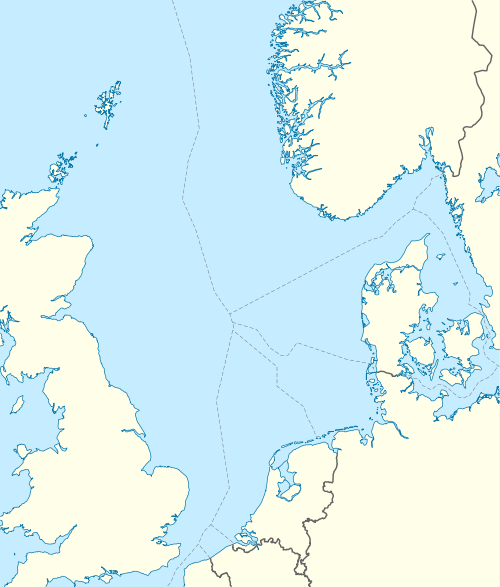Amethyst gasfield
| Amethyst gasfield | |
|---|---|
 Location of Amethyst gasfield | |
| Country | United Kingdom |
| Location | Southern North Sea |
| Blocks | 47/8a, 47/9a, 47/13a, 47/14a, 47/15a |
| Offshore/onshore | offshore |
| Coordinates | 53°38′N 0°37′E / 53.633°N 0.617°ECoordinates: 53°38′N 0°37′E / 53.633°N 0.617°E |
| Operator | BP |
| Partners | BP, Centrica, Murphy Oil |
| Field history | |
| Discovery | 1972 |
| Start of development | 1988 |
| Start of production | 1991 |
| Production | |
| Estimated gas in place | 1,100×109 cu ft (31×109 m3) |
| Producing formations | Lower Leman Sandstone Formation (Permian sandstone) |
Amethyst is a natural gas field in the Southern North Sea, about 30 miles (48 km) east of the Yorkshire coast. Gas lies in a Permian sandstone reservoir around 2,700 metres (8,900 ft) below the seabed. The gasfield is operated by BP.[1]
History
The gasfield was discovered in 1972 and it was named after HMS Amethyst.[1][2] Between 1972 and 1985 a number of appraisal wells were drilled. The field development started in 1988 and the first gas was produced in 1991.[1] Originally, the field was owned by BP, Enterprise Oil, British Gas, ARCO, Murphy Oil, Amerada Hess, and FINA. In 1997, BP acquired the interest of Enterprise Oil and became the largest stakeholder of the field.[3] As a result of restructuring and several transactions the field became hold by BP (59.5%), BG (24.15%), Centrica (8.95%), and Murphy Oil (7.4%).[1] In December 2009, BP and BG agreed an assets swap by which BP took over BG's interest in the field.[4]
In September 2007, three crew members of the emergency response and rescue vessel Viking Islay, operated by Vroon Offshore Services, were killed during a support operation on the Amethyst gasfield.[5]
Production
Production is performed using four small unmanned steel satellite wellhead platforms. The A1D platform and the A2D platform were built in 1989 by UiE Scotland in Glasgow, and have 5 and 6 wells respectively in Amethyst East. B1D and C1D were built in the following two years and currently produce from 4 and 7 wells in Amethyst East and Amethyst West respectively. C1D is connected to A1D and B1D is connected to A2D. All Amethyst daily operation and processing is carried out onshore. Personnel only travel to the platforms themselves for maintenance and well work. Produced gas is transported to the Easington Gas Terminal and sold to Électricité de France.[1]
See also
References
- 1 2 3 4 5 "The Amethyst Field" (PDF). BP. Retrieved 2010-06-28.
- ↑ "Dukes Wood Oil Museum". Nottinghamshire Wildlife Trust. Archived from the original on 8 July 2010. Retrieved 2010-06-28.
- ↑ Dorsey, Kristy (2007-04-29). "North Sea asset swap agreed". The Herald. Newsquest. Retrieved 2010-06-28.
- ↑ "BG and BP agree North Sea swap". Upstream Online. NHST Media Group. 2008-12-03. Retrieved 2010-06-28.
- ↑ "Crew deaths linked to anchor handling". Offshore Magazine. PennWell Corporation. 2007-09-24. Retrieved 2010-06-28.